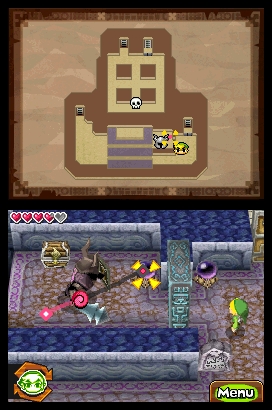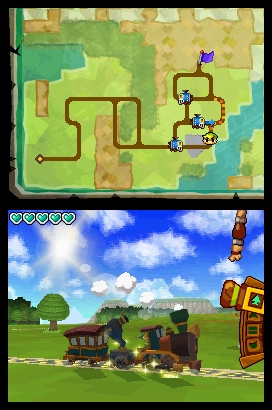|
|

|
PLATFORM
|
DS
|
BATTLE SYSTEM
|

|
INTERACTION
|

|
ORIGINALITY
|

|
STORY
|

|
MUSIC & SOUND
|

|
VISUALS
|

|
CHALLENGE
|
Easy
|
COMPLETION TIME
|
20-40 Hours
|
|
OVERALL

|
+ Gameplay refined from Phantom Hourglass.
+ Princess Zelda is adorable.
- Travel is slow and tedious.
- Sidequests and shortcuts nearly all linked to weak delivery subquests.
|
Click here for scoring definitions
|
|
|
The last time The Legend of Zelda made its way onto the Nintendo DS, it met with mixed response. While generally positive, most people noted a lack of polish that detracted from Phantom Hourglass's overall appeal. Following in its footsteps, The Legend of Zelda: Spirit Tracks improves on its predecessor in nearly every way, but still comes short of greatness.
Spirit Tracks takes us to the world of Hyrule a hundred years after the events of Phantom Hourglass. That isn't to say it's the same Hyrule as the one seen in Phantom Hourglass; rather, it's a new continent discovered by Link and Tetra, protagonists of Phantom Hourglass, that was, in typical Zelda fashion, also named Hyrule for the purposes of confusion. According to legend, an evil being was sealed away by the spirits beneath Hyrule and bound by chains which still cover the earth. These chains are the titular spirit tracks, and young Link, a descendant of Phantom Hourglass's hero, is a newly-licensed engineer. He meets up with Princess Zelda, a descendant of Tetra, encounters a malevolent evil, and is once again contracted to save the world when the perky princess gets poached. In a twist, however, only Princess Zelda's body is stolen; her spirit remains with Link as an ally, serving the role of the fairies of previous titles. It's Legend of Zelda: Buddy Cop style!
Spirit Tracks is actually a surprisingly plot-heavy game, for a Zelda title at least. The introductory sequences leading up to Zelda's ghostly transformation are surprisingly long, and although the main portion of the game is roughly standard as far as Zelda story-telling goes, the finale is even lengthier than the introduction. The main draw of the story, however, is the dynamic between Link and Zelda. This marks the first time in the series that the princess for whom the game derives its name actually does anything, and she proves to be a terrific sidekick for the game's silent, green-garbed hero.
It helps that the writing is superb. The dialogue, despite a few dry bits of exposition, is witty and filled with personality. The characters met along the way all have their goofy charms, but it's the young, disembodied princess that really stands out as terrific. There's even a bit of self-deprecating humor as a throwback to earlier titles. The writing is supported by terrific cutscene direction, making use of camera angles, close-ups, and other cinematic tricks that are unusual for most DS titles.
 Zelda's gotten butch.
Zelda's gotten butch.
|
|
Even blown up to full screen during a close-up, the visuals are terrific and a marked improvement over Phantom Hourglass. In particular, the environments no longer have the bland, empty appearance that many areas in its predecessor had. The models are all cel-shaded a la Wind Waker, and despite the limitations of the DS system, the pixelization is minimal.
The gameplay is a marked improvement in most respects as well. The stealth sections that were criticized in Hourglass have been shortened, and there's no longer any repeated areas to travel through. The combat has been adjusted and refined as well. Everything is controlled with the stylus as before, but the enemies have been redesigned to be more akin to classic 2-D Zelda foes. Most enemies can only be beaten by the use of one of the many tools you'll discover on your journey, and there's no longer any need to wait for a foe to attack so you can get behind them, leading to a faster and more enjoyable experience.
One of the more unusual aspects of Spirit Tracks is how often it uses the DS's microphone. Magical songs make a reappearance, played on the Spirit Flute, a panpipe that's played by blowing into the microphone while sliding the pipe across the screen. In most cases it works well, but for any song where the notes are not next to each other on the flute, it can be difficult to play. There's also a fan tool discovered early on that makes use of the microphone, though this doesn't have the problems associated with the flute.
The one aspect of Spirit Tracks that really stands out more than anything is the puzzle design, which is quite possibly the best and most mind-bending in the series. While the controls were refined to a razor's edge in Phantom Hourglass, Spirit Tracks has spent time refining the details. Some of the puzzles require incredibly complicated use of multiple tools in ways that aren't readily apparent. One new mechanic involves manipulating the environment, such as freezing water to create pathways or raising sand to access unreachable areas. Sections of the game also see Princess Zelda inhabiting the bodies of phantoms, allowing for truly mind-bending puzzles requiring both characters acting together.
 Riding a train has never been less fun.
Riding a train has never been less fun.
|
|
Not all the changes are positive, unfortunately. While the entire game is a refinement of the formula that Phantom Hourglass created, the new travel system has taken two steps backwards. The "Toon Link" series of Zelda games seems to be cursed with bad travel mechanics, but Phantom Hourglass did manage to significantly improve what was started in Wind Waker. Unfortunately, traveling by train proves to be more irritating than sailing was in the aforementioned GameCube title. Not only does the train move at an infuriatingly slow pace, but the track is also inhabited by invincible demon trains that require creative navigation to avoid, adding more time to the journey.
Probably the worst part of the travel is how much of it the game requires you to do. Virtually every side quest in the game, along with nearly every short-cut, is unlocked through a series of incredibly tedious delivery requests. Not that the short-cut system is particularly well-thought-out to begin with. Warp portals are scattered across the world, but each portal is a direct, two-way link. You can't select which portal you want to warp to, which makes it rather difficult to make good use of them.
Aside from the travel issue, Spirit Tracks is, in every way, a better game than Phantom Hourglass. Sadly, the travel gets so frustrating later in the game that it really drags the whole thing down. The whole thing takes just over twenty hours to complete, and although the combat in the game isn't particularly challenging, the puzzles could very well find you banging your head against a wall. Whether or not the game is worth playing will depend entirely on your tolerance for slow train rides.
Review Archives
|









